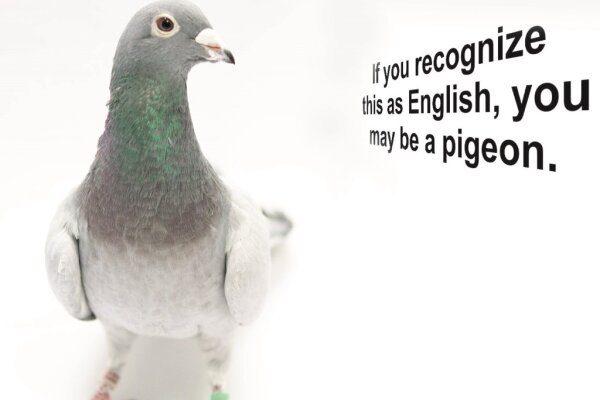2016-09-16

According to a new study published by biopsychologists from Bochum and the University of Otago (New Zealand), pigeons are able to discriminate English words from non-words. And they do this by orthographic rules that are identical to those used by humans. This enormous ability demonstrates that orthographic knowledge is no privilege of humans or primates but can be mastered by an animal with just 2.5 gram of brain. To demonstrate this feat, scientists first taught the birds top peck on words (e.g. DONE) shown on a monitor to obtain food. Pecking on non-words (e.g. DNOE) was not rewarded. Slowly the animals learned more and more English words (depending on the individual between 26 and 58) and discriminated them from non-words (about 8,000). Then came the real test: Pigeons were confronted with entirely new English words and non-words. The animals spontaneously discriminated successfully between the two groups of stimuli. Thus, they had learned what is typical for an English word. But how did they do this? A deeper analysis demonstrated that pigeons used two strategies. One was to use the frequency of bigrams in English. The word DONE has three bigrams: DO, ON, and NE. Their average bigram frequency is much higher than those of DN, NO, and OE in the non-word DNOE. The second strategy was the Levenshtein distance between two words which is the minimum number of single-character edits (i.e. insertions, deletions or substitutions) required to change one word into the other. Also humans utilize these two strategies for these kinds of decisions. The brains of birds and humans are vastly different. If still both species use the same strategy, it is likely that evolutionary selection pressure to identify regularities of input statistics are the relevant force that shaped brains during evolution. Whatever the genetically determined general outline of the brain of an animal was, its internal computations had to have the blueprint to solve these tasks. Within one week after its appearance, this paper was among the top 99.95% of all 6,365,760 scientific publications registered so far with respect to international media attention.

According to a new study published by biopsychologists from Bochum and the University of Otago (New Zealand), pigeons are able to discriminate English words from non-words. And they do this by orthographic rules that are identical to those used by humans. This enormous ability demonstrates that orthographic knowledge is no privilege of humans or primates but can be mastered by an animal with just 2.5 gram of brain. To demonstrate this feat, scientists first taught the birds top peck on words (e.g. DONE) shown on a monitor to obtain food. Pecking on non-words (e.g. DNOE) was not rewarded. Slowly the animals learned more and more English words (depending on the individual between 26 and 58) and discriminated them from non-words (about 8,000). Then came the real test: Pigeons were confronted with entirely new English words and non-words. The animals spontaneously discriminated successfully between the two groups of stimuli. Thus, they had learned what is typical for an English word. But how did they do this? A deeper analysis demonstrated that pigeons used two strategies. One was to use the frequency of bigrams in English. The word DONE has three bigrams: DO, ON, and NE. Their average bigram frequency is much higher than those of DN, NO, and OE in the non-word DNOE. The second strategy was the Levenshtein distance between two words which is the minimum number of single-character edits (i.e. insertions, deletions or substitutions) required to change one word into the other. Also humans utilize these two strategies for these kinds of decisions. The brains of birds and humans are vastly different. If still both species use the same strategy, it is likely that evolutionary selection pressure to identify regularities of input statistics are the relevant force that shaped brains during evolution. Whatever the genetically determined general outline of the brain of an animal was, its internal computations had to have the blueprint to solve these tasks. Within one week after its appearance, this paper was among the top 99.95% of all 6,365,760 scientific publications registered so far with respect to international media attention.